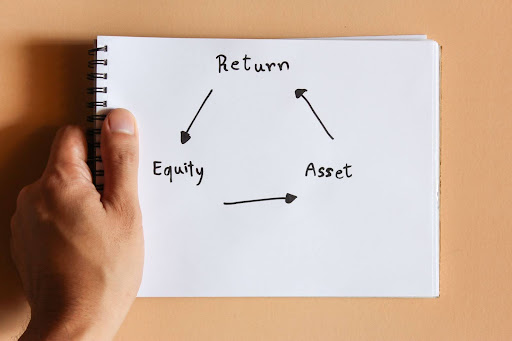Return on equity (ROE) is an important metric used to evaluate the success of real estate investments and can be applied to commercial and residential properties. Whether you are a seasoned investor or just starting, understanding what return on equity is and using the return on equity formula are essential in gauging how well your money is working for you in the real estate market.
What Is Return on Equity?
Return on equity for real estate is a measure of the income returned on the equity invested in a property. It is a percentage figure that reflects how effectively an investor’s funds are being utilized to generate profit. Calculating real estate ROE is insightful because it focuses solely on the investor’s contribution and does not include external factors like mortgages or loans.

It clarifies how well the equity portion of the investment is performing, irrespective of the property’s overall value or the impact of borrowed funds. ROE, therefore, becomes a pure measure of the return on the investor’s capital.
Why Should Investors Care About ROE?
Investors should care about ROE because it’s like a health check for their investment. It answers the crucial question: “Is my money being used effectively to generate profits?” By looking at ROE, investors can see how well their own money (equity) is working for them in the investment. Investors can also use ROE to help identify properties that are not only high performing in terms of total value but also efficient in terms of equity utilization. If ROE is high, it means their investment is doing well at turning their money into more money.

Investors often rely on ROE to evaluate and contrast various investment options. This metric zeroes in on the equity aspect, allowing for a direct comparison of different investments’ profitability, independent of their scale or the amount of financing involved. By estimating the anticipated income a property might generate, you can calculate its ROE using the equity you plan to invest.
Calculating ROE is especially useful in real estate because investors often use a mix of their own money and loans. A good ROE shows that their personal investment is paying off well. This allows an investor to make smart and informed decisions about where to invest and how to manage their real estate portfolio.
Difference Between ROE & Return on Investment (ROI)
ROE and ROI are both critical metrics when looking at investments, but they serve different purposes. ROE focuses on the profitability generated from the personal capital invested. In contrast, ROI evaluates the total return on an investment relative to the total cost, including equity and borrowed funds.
Here’s a table comparing ROE and ROI:
Return on Equity (ROE) | Return on Investment (ROI) | |
|---|---|---|
Definition | Measures the return earned on the equity portion of an investment. | Measures the total return on the overall investment, including equity and debt. |
Focus | Focuses specifically on the efficiency and profitability of the investor's own capital. | Encompasses the entire investment, providing a holistic view of its performance. |
Calculation | Calculated by dividing net income by the investor's equity. | Calculated by dividing the total profit of the investment by the total investment cost. |
Purpose | Used to assess how effectively an investor's personal funds generate income. | Used to evaluate the overall success and profitability of the investment. |
Usage | Ideal for comparing the performance of equity across different investments. | Suitable for assessing the overall performance and making decisions about the investment as a whole. |
Equation Results | High ROE indicates efficient use of personal equity but doesn’t account for debt. | High ROI shows overall investment success, including both debt and equity returns. |
The distinction between these two metrics is crucial for investors to understand. ROI is a broader measure that considers the entire investment structure to make it useful for evaluating the total efficiency of an investment. However, ROE offers a more nuanced view by highlighting the effectiveness of the equity component alone. Investors often use both metrics in tandem to gain a complete picture of their investment’s performance and to make more informed decisions.
How to Calculate Return on Equity
The return on equity calculator utilizes a simple formula to calculate ROE. Investors must divide the net income generated by a property by the equity invested in it. Here’s how it works:
ROE = (Net Income/Shareholder Equity) × 100
Here’s how each component is defined in the return on equity real estate formula:
Net income: This is the annual income generated by the property after accounting for all operating expenses, taxes, and maintenance costs, but before paying any mortgage or loan interest. This income can come from rental revenue or other property-related income streams.
Shareholder equity: The equity definition in real estate represents the investor’s personal investment in the property. It includes the down payment and any additional funds invested in the property for improvements or renovations. It may also account for the principal portion of any mortgage payments made, which increases the equity over time.
Examples of a ROE Calculation:
Example 1: An investor puts a down payment of $50,000 on a property and incurs additional costs of $10,000 in renovations, making the total equity investment $60,000. The property generates a net income of $6,000 a year.
- Net income = $6,000
- Equity = $60,000 (initial down payment)
$6,000/$60,000 × 100 = 10% ROE
Example 2: An investor purchases a rental property for $300,000. They make a down payment of $60,000 (20% of the purchase price) and take a mortgage for the remaining $240,000. Over the year, the property generates rental income of $24,000. Operating expenses (maintenance, taxes, insurance, etc.) for the year amount to $6,000. Therefore, the net income from the property (rental income minus operating expenses) is $24,000 – $6,000 = $18,000.
- Net income = $18,000
- Equity = $60,000 (initial down payment)
$60,000/$18,000 × 100 = 30% ROE
How ROE Affects Investment Health
Understanding what is a good ROI in real estate is essential for assessing the overall health of real estate investments. ROE serves as a key indicator, revealing the effectiveness of the equity invested in properties. By carefully analyzing ROE, investors can gain valuable insights into the performance of their equity, which can help shape their investment strategies. The influence of ROE on investment health can be explored through various dimensions:
- High ROE signals efficient use of equity: It means the equity portion of the investment is yielding substantial returns.
- Low ROE points to underperformance: It suggests that the investment isn’t generating sufficient income relative to the equity invested.
- ROE reflects the effectiveness of leveraging: By showing how well-borrowed funds are used alongside personal equity, it indicates the success of the leveraging strategy.
- Investors use ROE to compare different properties: It helps evaluate which investments are more efficient in terms of equity use.
- ROE is crucial for portfolio diversification: It guides investors on where to allocate more capital for better returns, contributing to a well-balanced investment portfolio.
- Changes in ROE prompt timely decisions: Adjustments, such as restructuring financing, selling, or increasing investment in a property, might be necessary to optimize returns.
- Low ROE strategies aim to increase returns: This might involve methods to enhance rental income, reduce operational costs, or improve financing terms.
- High ROE strategies focus on growth and reinvestment: For successful investments, strategies might include reinvesting profits or expanding the property portfolio to leverage high returns.
Situations Where ROE Doesn’t Matter as an Investor
There are certain situations in real estate investing where ROE might not be the primary focus or may not matter as much. In each scenario, while ROE remains an important metric, it might not be the dominant factor guiding investment decisions. Investors often consider a combination of factors, including market trends, personal goals, risk tolerance, and financial strategies alongside ROE.
- Long-term growth focus: Investors prioritizing long-term property appreciation over immediate income might not emphasize ROE.
- Market conditions: In rapidly appreciating markets, investors might be more interested in the potential increase in property value rather than current income returns.
- Tax considerations: Some investment strategies focus on tax benefits, such as deductions for mortgage interest, depreciation, or deferring taxes. In these scenarios, the tax advantages might outweigh immediate equity returns.
- Strategic equity buildup: Investors who are more focused on paying down mortgage debt to build equity might not consider ROE as their primary metric.
- Diversification strategies: Investors diversifying their portfolio might accept lower ROE in exchange for reduced risk or exposure to different market segments.
- Personal use properties: For properties that are partly personal use (like a vacation home), the ROE may be less relevant. The value here is in personal enjoyment and utility rather than financial returns.
- Development projects: In real estate development, the immediate ROE may not be a significant factor during the development phase. This is because developers may be more focused on creating value through property development or renovation.
- High liquidity needs: Investors who prioritize liquidity over returns might not focus on ROE. Their main concern could be the ease of converting the investment into cash rather than the return on equity.
Frequently Asked Questions (FAQs)
A good ROE varies depending on market conditions, property type, and investment strategy. Generally, a higher ROE indicates a more efficient use of equity. Investors often look for ROE that exceeds average market returns or outperforms other investment options available to them. However, what constitutes a “good” ROE can vary significantly from one market or investment strategy to another.
Improving ROE in real estate can be achieved in several ways. Increasing rental income, reducing operational costs, and refinancing to a lower interest rate can boost net income, thereby improving ROE. Additionally, strategic property improvements that increase value or desirability can also raise rental income potential. However, it’s important to balance the cost of these improvements against the potential increase in income.
While a high ROE is generally positive, it doesn’t automatically mean an investment is good. A high ROE might result from high leverage (use of debt), which can also increase risk. It’s crucial to consider other factors like market stability, property location, potential for appreciation, and overall investment risk. A comprehensive analysis beyond just ROE is essential for making well-informed investment decisions.
Bottom Line
Understanding return on equity is crucial for real estate investors. It is a fundamental metric for real estate investors that offers a clear lens through which to view the efficiency and profitability of their investments. A good ROE not only signifies a healthy return on the investor’s own capital, but also guides strategic decision-making in portfolio management and investment selections. Knowing how to calculate the rate of return on equity and effectively utilizing ROE can lead to more informed investment choices that ultimately contribute to a profitable real estate portfolio.